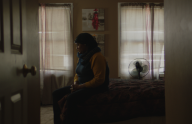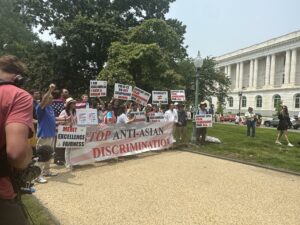A decades-old SCOTUS ruling could impact the future of race-based college admissions policies

Barbara Grutter was no stranger to a challenge. She worked in a doctor’s office while getting her Bachelor of Science degree in 1978, when few women did. She raised two small children while learning information systems, when the concept barely existed. Later she founded and ran an IT consulting business, training healthcare companies to manage their data systems, while studying to go to law school.
When Barbara took the LSAT in 1996, at the age of 43, she scored in the top 15 percent of all her peers. She set her sights on the University of Michigan Law School, which offered her chosen specialty of health law. She compiled an application, wrote her essays, and mailed them in.
Weeks later she received her response from the school. Michigan waitlisted her, and shortly after, rejected her. But Barbara seemed to be exactly what Michigan Law said they were looking for, with a strong undergraduate record (at the University of Michigan itself), stellar LSAT scores, and experience in the corporate world and running her own business. She was also a woman and a returning student, all traits that the University of Michigan General Counsel Marvin Krislov would later say, “absolutely qualify for considerations in bringing diversity attributes.”
Barbara was accepted at Wayne State University Law, only a little farther away, and was even offered a scholarship, but the health law program wasn’t as strong as her alma mater’s.
Days after receiving her rejection, Barbara read an article in a Detroit newspaper, which listed the test scores and grades of applicants to Michigan Law. What she read troubled her.
In an attempt to address historic exclusion, Michigan had begun preferentially admitting black students and other minority applicants. Students with test scores and qualifications similar to Barbara’s had a 100 percent acceptance rate if they happened to belong to what the college deemed a racial minority. Among students who were white or Asian, with similar qualifications, fewer than 20 percent were admitted. Barbara’s chances of acceptance to her chosen program, it seemed, were cut by 80 percent because of her race.
“I had always taught (my kids) discrimination was wrong and the law protects them from that,” Barbara recalled years later. I could have been angry and bitter—or whined about it—or I could do something positive.”
Barbara wrote to her local member of the Michigan House of Representatives. He heard Barbara’s story and asked her to meet with the Center for Individual Rights (CIR), a public interest law firm that shared her concerns about Michigan Law’s new policy. CIR made Barbara a co-plaintiff in a lawsuit challenging U of M’s law school admissions, along with Jennifer Gratz and Patrick Hamacher, who were challenging similar practices for undergraduates.
CIR and Barbara’s fellow plaintiffs argued the intention of President John F. Kennedy’s Executive Order 10925, which required contractors working with the federal government to “take affirmative action to ensure that applicants are employed, and that employees are treated during employment, without regard to their race, creed, color or national origin.”
The goal of Kennedy’s order, and its extension into education policy in 1968, was to end racial and religious discrimination in public schools. But Michigan Law’s policy, as implemented, was excluding Barbara, and hundreds of other students, from the program because of race.
What did the courts have to say?
In U.S. District Court, the University of Michigan argued that only racial bans and explicit quotas had been found unconstitutional by a previous ruling, Regents of the University of California v. Bakke. As long as race was only one of the criteria considered, the university said, it wasn’t illegal to discriminate. Their justification—that including race in the university admissions policy was necessary to admit a “critical mass” of minority students—sounded a lot like an illegal quota system to Barbara and CIR. As it turned out, District Judge Bernard Friedman agreed, placing an injunction on the university policy, which he called, “indistinguishable from a straight quota system.”
But the University of Michigan appealed.
In 2001, the entire Sixth Circuit heard both Grutter v. Bollinger and Gratz v. Bollinger, the Michigan undergraduate cases. All nine judges sat, instead of the usual three-judge panel, and overturned the District Court’s ruling. Michigan’s use of race to decide which students to admit was vindicated.
Stunned, CIR and Barbara appealed to the Supreme Court (SCOTUS).
In June 2003, six years after Barbara received bad news from Michigan’s admissions office, she got more bad news from SCOTUS. In Barbara’s case, SCOTUS decided that using race as a factor in college admissions is not necessarily a violation of the Fourteenth Amendment, which reads:
No State shall make or enforce any law which shall abridge the privileges or immunities of citizens of the United States; nor shall any State deprive any person of life, liberty, or property, without due process of law; nor deny to any person within its jurisdiction the equal protection of the laws.
Nor was Michigan’s policy, according to the 5-4 decision delivered by Justice Sandra Day O’Conner, a violation of the 1964 Civil Rights Act, which reads:
No person in the United States shall, on the ground of race, color, or national origin, be excluded from participation in, be denied the benefits of, or be subjected to discrimination under any program or activity receiving Federal financial assistance.
Was Barbara offered equal protection by the University of Michigan, which receives federal funds? Was she, on the basis of race, color, or national origin, excluded from participation in the University of Michigan’s Law School? The school’s own numbers (the result of its written policy) strongly suggest someone with Barbara’s qualifications, had she been of a different race, would have been admitted to the program.
While the Grutter case is long since decided, and Barbara returned to her consulting business and children, the questions she raised and the justice she sought are again seeing momentum in the judicial landscape.
Harvard and UNC under fire
In November, SCOTUS heard arguments in two related cases Students for Fair Admissions v. Harvard and Students for Fair Admissions v. University of North Carolina—which question whether colleges and universities can use race as a qualifying factor when considering an applicant for admissions.
Students for Fair Admissions’ (SFFA) concerns arose from Harvard’s admissions policies which discriminate against Asian applicants. The same concerns arose at the University of North Carolina.
The problem is so widely recognized that even college prep company Princeton Review counsels Asian American students to conceal their racial identity as much as possible, going so far as to advise that they steer away from mentioning any involvement or aspirations in the math or medical fields.
For 20 years, Grutter established a legal precedent that has permitted colleges to screen highly qualified applicants on the basis of race, allegedly for the legitimate government interest of maintaining a particular racial mix in their student body.
Harvard and UNC believe that ruling should be applied in this instance as well, arguing that its use of race is just one factor of many and is in the legitimate interest of the government in order to foster diversity among the student body,
SFFA disagrees on the grounds that both schools’ policies are a clear violation of the equal protection clause.
Pacific Legal Foundation agrees and filed an amicus brief on behalf of SFFA in both the Harvard and UNC cases.
Using racial identity, rather than individual merit, to evaluate a student for admissions is constitutionally prohibited—plain and simple.
The outcome of both these cases hinges heavily on the Grutter ruling, which is why it was mentioned numerous times throughout the nearly five-hour oral arguments.
If the Justices side with Harvard and UNC, the precedent in Grutter will hold strong.
If the Court sides with SFFA, Grutter could be overturned this year. That would best by five years the prediction of Sandra Day O’Connor, who wrote in the 2003 majority opinion in Grutter v. Bollinger, “We expect that 25 years from now, the use of racial preferences will no longer be necessary to further the interest approved today.”
The future of equality in education
The outcome of these cases will likely have implications that extend far beyond higher education. They could impact the admissions processes in K-12 education as well, an issue at the heart of the Pacific Legal Foundation case, Coalition for TJ v. Fairfax County School Board.
Thomas Jefferson High School for Science and Technology (TJ), the top public high school in the country, recently abolished its rigorous entrance exam in favor of inscrutable “holistic admissions” that would use race, rather than individual merit, as a major factor in admissions.
The policy change, promoted as a matter of “equity,” clearly targeted Asian American students, as evidenced by public statements and text messages by school board members.
PLF is fighting alongside Coalition for TJ, a group of concerned parents, students, and alumni, to protect the promise of equality before the law.
The coalition won its case at the district court, and it’s now on appeal at the Fourth Circuit Court of Appeals.
With the issue of race-based admissions policies—and the accompanying war on academic merit—being widely debated across the country, the impending SFFA decision could open the door for SCOTUS to take on a case like TJ.
Treating people as individuals—not representatives of groups—is the only sustainable approach to justice: racial, social, or otherwise. This is a big moment for the fate of equality in the country. Let’s hope the Court gets it right.









